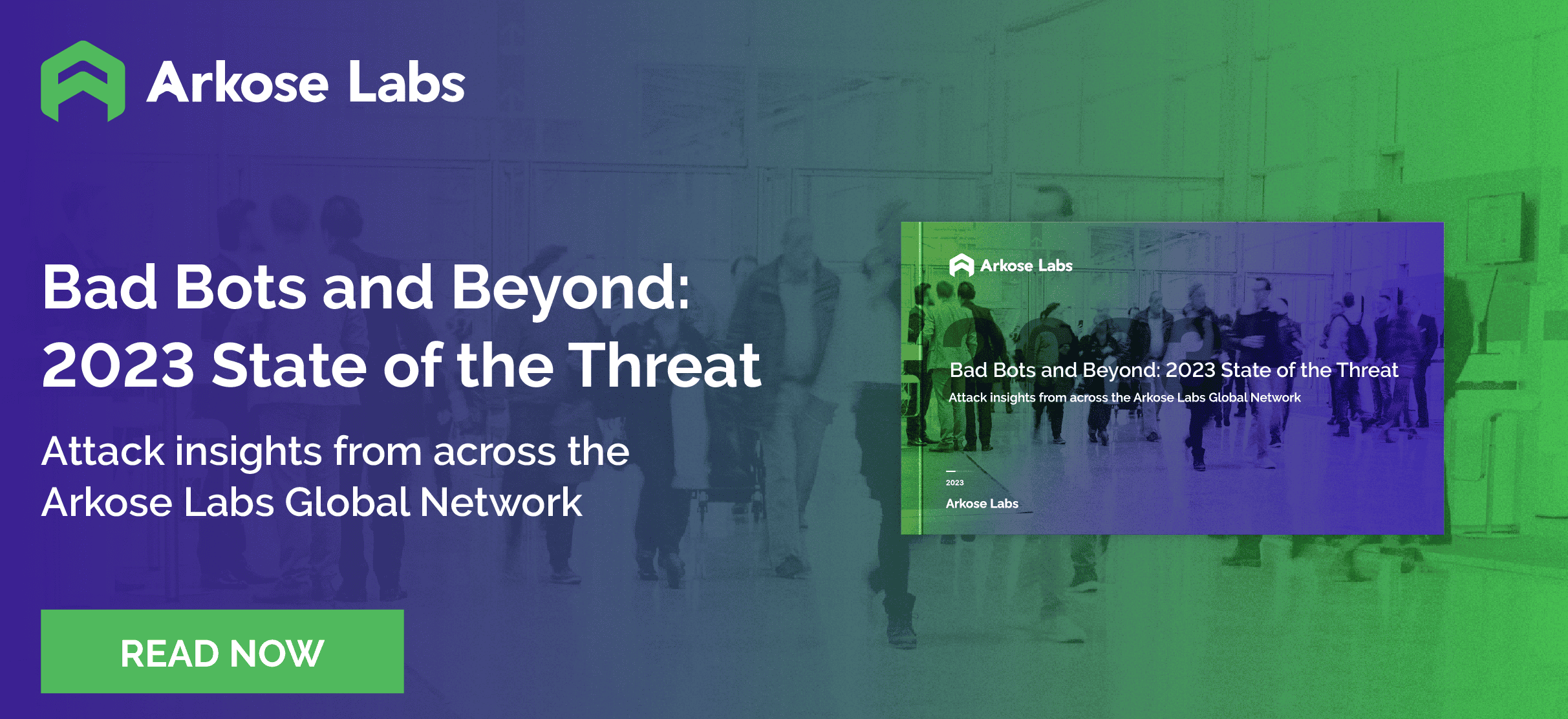Threat actors are always looking for new ways to deceive businesses and individuals. They're constantly evolving their tactics to stay ahead of the game, meaning it's essential to stay up-to-date with the latest fraud trends. Stay informed and stay ahead of the game with our comprehensive guide to the latest fraud trends.
Looking to stay ahead of current trends in cybercrime? Read our 2023 Cybercrime Prevention Playbook and get started!
Overview of current fraud trends
The current fraud landscape is constantly evolving, and it's essential to keep up with the latest trends. Identity theft and account takeover continue to be major issues across different industries.
However, the rise of mobile payments and ecommerce has led to an increase in online fraud. Moreover, small businesses are also vulnerable to social engineering tactics like fake invoices or impersonating vendors. To stay ahead of these trends, organizations must invest in fraud prevention tools and keep themselves up-to-date on the latest scams employed by fraudsters.
How bots enable cybercrime and fraud
Bots have become a popular tool for cybercriminals, allowing them to carry out various types of fraud, such as account takeovers and fake ad clicks and can even be used to send phishing, spam, and ransomware messages. Many bots are becoming more sophisticated and are backed by artificial intelligence (AI) and machine learning (ML). Their ability to mimic human behavior on the internet makes them difficult to detect and block through traditional security measures. To combat bot-enabled fraud, businesses can implement anti-bot solutions that use machine learning algorithms to identify suspicious behavior and prevent attacks in real-time.
Current fraud trends
As technology advances, so do the methods of cybercriminals seeking to defraud individuals and organizations alike. From phishing attacks to account takeover scams, the current fraud trends in cybersecurity demonstrate the increasing sophistication and complexity of these threats. The consequences of these attacks can be devastating, resulting in financial losses, data breaches, and damage to reputation. In order to stay protected, it is essential for individuals and businesses to remain vigilant and implement robust security measures to mitigate the risks posed by these evolving fraud trends.
Rise of synthetic identities
Identity theft has been a significant concern for businesses, but the rise of synthetic identities has introduced a new level of complexity. Synthetic identities are created by combining real and fake information to create a new identity that can be used for fraudulent activities. The challenge for businesses is that traditional identity verification methods may not detect these synthetic identities because they appear legitimate on the surface.
To combat synthetic identity fraud, financial institutions must implement advanced identity verification technologies that can identify fake or manipulated data points. Additionally, monitoring suspicious activities such as large purchases or money transfers can provide an early warning signal that fraudulent activity may be occurring.
Account takeover fraud
The rising number of data breaches and hacking incidents has given rise to one of the most prevalent forms of fraud - account takeover. This occurs when a fraudster gains access to a legitimate user's account, including usernames and passwords, and takes control over it. Social engineering tactics or phishing attacks are common methods used by fraudsters to obtain login information. Login credentials can also be bought on the dark web, or leaked as part of a data breach.
To prevent account takeover fraud, businesses can implement multi-factor authentication, monitor accounts for suspicious activity, and educate users on how to protect their login information. By doing so, businesses can better safeguard their customer's sensitive information and create a secure environment for all parties involved.
The impact of cryptocurrencies on fraud trends
Cryptocurrencies have revolutionized the financial landscape and created new opportunities for fraudsters. The decentralized and unregulated nature of cryptocurrencies makes it difficult to trace fraudulent transactions, making them an attractive target for cybercriminals. Besides, the anonymity associated with cryptocurrency transactions makes it easier for criminals to remain undetected. This has led to a rise in cryptocurrency-related scams, including fake initial coin offerings (ICOs) and Ponzi schemes, costing investors millions of dollars.
To prevent fraud related to cryptocurrencies, increased awareness and education on cryptocurrency scams are necessary to protect investors from falling victim to these fraudulent schemes. Additionally, implementing effective security measures like two-factor authentication can help mitigate the risk of unauthorized access to wallets and exchanges.
Stopping cybercrime and fraud
Stopping cybercrime and fraud is an ongoing challenge in the rapidly evolving digital landscape. As technology continues to advance, so do the methods employed by cybercriminals seeking to exploit vulnerabilities and defraud individuals and businesses alike. The consequences of these attacks can be severe, ranging from financial losses and data breaches to reputational damage and legal liabilities. In order to mitigate these risks, it is crucial for organizations to stay informed about the latest threats and implement effective security measures to safeguard against them. From fraud detection to incident response, the fight against cybercrime requires a multi-faceted approach that is both proactive and reactive.
Preventing social engineering attacks
In today's digital age, social engineering attacks have become increasingly common and sophisticated. Attackers use various techniques to trick employees into divulging sensitive company information or data. To prevent such attacks, businesses must first educate their employees on how to identify and respond to social engineering tactics. This can include training sessions on how to recognize phishing emails, detect fraudulent phone calls, and avoid suspicious website links. Implementing strict security protocols such as multi-factor authentication and password policies can further strengthen defenses against social engineering attacks. By fostering a culture of vigilance in the workplace, businesses can create a strong defense against this type of fraud.
Combatting bots and malware that extract user information
Malware and bots are the weapons of choice for cybercriminals seeking to harvest personal information from websites. These malicious tools can be challenging to detect, and once they infect a system, they can cause significant harm. Implementing security measures such as CAPTCHA, two-factor authentication, and firewalls can help to prevent bot attacks. Regular monitoring of website traffic and behavior can identify suspicious activity before it becomes catastrophic. Keeping software up-to-date and regularly scanning for malware is critical in fighting against these threats.
Ensuring ACH and check deposit fraud protection
Protecting against ACH and check deposit fraud is critical for businesses of all sizes. One effective way to prevent ACH and check deposit fraud is to use multi-factor authentication for online banking transactions. This adds an extra layer of protection by requiring users to enter a second form of identification, such as a code or PIN. Additionally, monitoring account activity regularly can help detect any suspicious behavior early on, allowing companies to take action before significant damage occurs.
Training employees on how to identify and report potential fraud attempts is also crucial in preventing ACH and check deposit fraud. With positive pay, businesses can match checks presented for payment with a pre-approved list, reducing the risk of fraudulent activity. Finally, utilizing fraud detection tools provided by banks or third-party vendors can provide further protection against ACH and check deposit fraud.
False positives and the hidden threat they pose
Businesses must balance the need for fraud prevention with the risk of false positives. Customers expect a smooth transaction process, and any inconvenience caused by false positives can lead to lost revenue and damage to a company's reputation. Moreover, false positives can push customers towards competitors who offer a more seamless experience. Companies need to find the right balance between fraud prevention and minimizing false positives through advanced technology and intelligent risk assessment.
Balancing fraud prevention with customer friction
Finding the right balance between friction associated with fraud prevention and customer experience is crucial for businesses. While it's essential to have robust fraud detection measures in place, overly aggressive or intrusive methods can create friction and negatively impact the customer journey. To avoid this, businesses must use data analytics to identify patterns and trends in fraudulent activity, implement multi-factor authentication, and continuously monitor and update their fraud prevention strategies as new threats emerge. By doing so, businesses can strike a balance that protects sensitive data without compromising the customer experience.
Bot management and fraud prevention with Arkose Labs
For too long, businesses have accepted fraud losses as a ‘cost of doing business’ which perpetuates the problem and provides the financial incentive for fraudsters worldwide. Rather than playing a constant game of cat-and-mouse with the bad guys, Arkose Labs gets to the root of the problem by removing the economic incentive for fraudsters to even attack in the first place. In the end they are compelled to give up their attacks and choose a different target.
Arkose Labs provides a more robust approach to stamping fraud with a platform that combines risk-based decisioning and targeted friction. Real-time risk assessments inform a unique challenge-response mechanism, Arkose MatchKey, which uses incrementally complex puzzles to sap fraudsters’ resources and eliminate unauthorized payments. Better yet, legitimate customers will experience little to no friction at all.
Book a demo today to learn more about how Arkose Labs can support your business in the fight against cybercrime.

Bad Bots and Beyond: 2023 State of the Threat Report
- Overview of current fraud trends
- How bots enable cybercrime and fraud
- Current fraud trends
- Rise of synthetic identities
- Account takeover fraud
- The impact of cryptocurrencies on fraud trends
- Stopping cybercrime and fraud
- Preventing social engineering attacks
- Combatting bots and malware that extract user information
- Ensuring ACH and check deposit fraud protection
- False positives and the hidden threat they pose
- Balancing fraud prevention with customer friction
- Bot management and fraud prevention with Arkose Labs

